Fery
International Hazard
    
Posts: 1026
Registered: 27-8-2019
Location: Czechoslovakia
Member Is Offline
|
|
allyl valerate - pineapple ester
To 1 L RBF was placed:
valeric acid 102 g 1 mol
allyl alcohol 70 g (approx 15% excess), from which the whole fraction boiling below 96 C containing some water was all used - that 56,1 g fraction.
200 ml hexane enriched in allyl alcohol (from the allyl alcohol dehydratation here https://www.sciencemadness.org/whisper/viewthread.php?tid=15...) containing unknow amount of extra allyl alcohol
5 ml conc. H3PO4
boiling chips
Dean-Stark trap adapter attached + rfx condenser and refluxed on boiling water bath in a pot (replacing the evaporated water a lot). After 3,5 hours
20 ml of bottom phase separated (H2O + allyl alcohol) and after 8,5 hours 45 ml separated totally (salting the 45 ml with K2CO3 yielded approx the
same volume of bottom water phase and upper alcohol phase).
Cooled down to RT and washed with 250 ml of water in 1 L separatory funnel.
Then washed 3x with 100 ml of approx 7 % solution of NaHCO3 with massive evolution of CO2 even at the last washing, so I decided to perform fourth
washing again with 100 ml NaHCO3 and again massive CO2 evolution but the bottom layer which should contain unreacted NaHCO3 after acidifying did not
produce any CO2 bubbles anymore so NaHCO3 seemed to be used up completely. Then I resigned for further washing with NaHCO3 with a fear of decomposing
all the ester back to allyl alcohol + Na valerate. And performed final washings with just water (2 x 250 ml).
Dried with Na2SO4.
Performed simple distillation using 500 ml RBF and oil bath, first distilled out all the hexane, then collected fraction boiling in range 162-168 C
(b.p. 164-165 lit.) which weighed 44,9 g and also approx 15 ml of fraction 168-171 which had the same scent as the main fraction (no traces of valeric
acid smelled in it, b.p. of valeric acid 186 C).
Now I would like to ask you all, did you experience some ester which hydrolysed rapidly even in NaHCO3 solution? Perhaps the allyl group makes the
allyl valerate very prone for hydrolysis ?
I also believe that just direct esterification without removing water from the reaction would result in only very poor yield.
If you try it, do not wash it too much with NaHCO3 because of hydrolysis. Using slight excess of allyl alcohol + using Dean-Stark trap adapter for
removing all the water formed in the reaction made all the valeric acid to react. Note not only water separated in the Dean-Stark trap adapter but
also some allyl alcohol, that's why approx at least 20 % excess of the alcohol necessary (assuming bottom layer in the trap is water : allyl alcohol
1:1 and 1 mol of H2O is 18 ml + some extra water from not 100% dry alcohol).
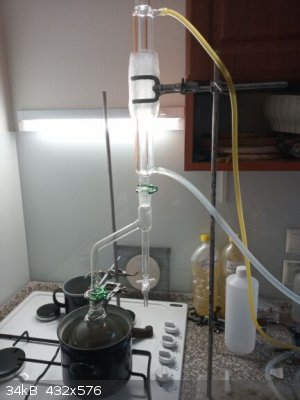   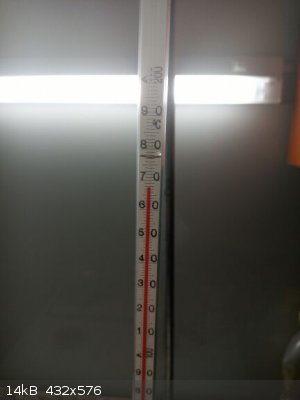
|
|
|
Fery
International Hazard
    
Posts: 1026
Registered: 27-8-2019
Location: Czechoslovakia
Member Is Offline
|
|
I redistilled the product again now using appropriate 100 ml RBF (previously it was from 500 ml RBF due to additional 200 ml hexane content). I was
prepared to start collecting at 164 C but the temperature quickly rose to 168 C (perhaps only latency of thermometer to heat its bulb sufficiently
when distilling such small amount?) and most of the product passed 168-173 C.
I tried to react 1 ml of the redistilled product with 5% solution of NaHCO3 in very small 25 ml Erlenmeyer flask and now again massive CO2 evolution -
must be shaken vigorously to break it into very small droplets, I stoppered the neck of the flask with my thumb and shaken thoroughly, mild mixing is
not enough - like just rotating the flask a bit in a hand). There aren't any traces of free valeric acid which could evolve CO2 too. The scent is
beautiful pineapple. Even traces of valeric acid would introduce nasty vomiting smell.
yield 48,4 g
Previous distillation of the ester from 500 ml flask passed very quickly in about 2 minutes as the RBF was almost empty after distilling out 200 ml of
hexane, now from the 100 ml flask the distillation took 10 minutes so the separation was better.
Strange that internet sources claim b.p. 164-165 C, perhaps my ester was purer? Or thermometer calibration error?
I definitely suggest to perform the esterification with an excess of allyl alcohol, remove all water from the reaction using Dean-Stark trap adapter
(don't forget the loses of allyl alcohol with the water) thus made all valeric acid to react and not to treat the crude ester with NaHCO3 solution
(unnecessary thanks to no valeric acid present), wash the crude product just with water to remove the catalyst and excess of allyl alcohol.
here pictures of time-temperature values when redistilling from 100 ml RBF
time / temperature
10:46:26 164 C
10:47:46 168 C
10:51:00 170 C
10:53:27 171 C
10:56:28 173 C
 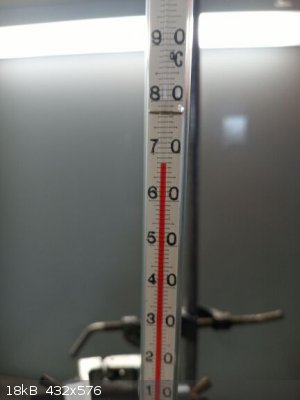   
|
|
|
j_sum1
Administrator
       
Posts: 6333
Registered: 4-10-2014
Location: At home
Member Is Offline
Mood: Most of the ducks are in a row
|
|
Lovely work. Is there an alternatrive to NaHCO3 washing that does not risk hydrolysis?
15mL seems a very low yield from your starting reagents. Still, it seems a great accomplishment and it does not take a whole lot of ester to smell
lovely.
Do you have a purpose for the product?
|
|
|
njl
National Hazard
   
Posts: 609
Registered: 26-11-2019
Location: under the sycamore tree
Member Is Offline
Mood: ambivalent
|
|
@j_sum1 unless I've misread the writeup the yield was ~48 grams?
|
|
|
Amos
International Hazard
    
Posts: 1406
Registered: 25-3-2014
Location: Yes
Member Is Offline
Mood: No
|
|
If you're working with anything high-boiling you're sure to have a pretty lengthy distillation, so it's absolutely imperative that you take a good
long while to wash out any bases that could still be hanging around in your organic layer, and also dry it extremely thoroughly. Every drop of water
you introduce during washing is going to undo the hard work you did with the Dean-Stark trap. I have not encountered significant evidence of
hydrolysis with Na2CO3 washing of my reaction mixtures unless the contents of my sep funnel were hot. If this is one instance where the ester is
extremely susceptible to hydrolysis, you could experimentally try vacuum filtering it through calcium carbonate, or perhaps washing it with a fairly
neutral buffer solution like Na2HPO3.
[Edited on 2-28-2020 by Amos]
|
|
|
j_sum1
Administrator
       
Posts: 6333
Registered: 4-10-2014
Location: At home
Member Is Offline
Mood: Most of the ducks are in a row
|
|
Uh. Thanks. I was reading on my phone and missed that detail when I scrolled back up to re-read. 48g sounds pretty good: especially for a first,
unoptimised attempt. Like I said, good work.
|
|
|
Fery
International Hazard
    
Posts: 1026
Registered: 27-8-2019
Location: Czechoslovakia
Member Is Offline
|
|
j_sum I did it because of pineapple scent. I have almost every aliphatic carboxylic acid upto C9 (all including branched for upto C5 and only straight
chain C6-C9) and I searched which esters have pineapple scent and especially pure pineapple as a lot of them are not pure pineapple.
I suggest not to wash it with NaHCO3 at all but perform the synthesis in a way that all valeric acid reacts so no need to wash with NaHCO3 - using
Dean-Stark trap adapter and approx 20% excess of allyl alcohol. I have 500 ml of commercial allyl alcohol in a sealed ampule but I did not have heart
to break the ampule so I tried the allyl alcohol synthesis and dehydratation which could be helpful to other forumers too. I have also 1 l of allyl
bromide (Sigma Aldrich) so I can perform Na valerate + allyl bromide too. But I wanted to perform such a synthesis which most of you can reproduce
(for most of forumers the limiting reagent is valeric acid, I have almost 2 liters of it in stock, I bought it at a price 90 EUR per 1 l).
The 100% yield would be approx 150 ml. But I approximate half of the ester was destroyed by half a mole of NaHCO3 while washing and from the rest
which survived the NaHCO3 assassination attack I collected 48,4 g after the distillation.
I'm quite skilled in ester syntheses and their work-ups so I know well how the first NaHCO3 washing produces a lot of CO2, the second washing only a
little of CO2 and the third washing almost no CO2 (most of procedures from universities contain only 2 washings with NaHCO3), I use also an universal
indicator paper to check to be sure that no acid left after washings as they have ugly smell even at low concentration... But here in allyl valerate I
realized too late that it had been decomposed. No traces of valeric acid in the ester. After acidifying the washings the formerly NaHCO3 did not
further evolve any CO2 so all NaHCO3 consumed during washing of the allyl valerate which was terrible observation. The first clue which I omitted but
realized later was that the first washings with H2O wash out most of anorganic acid if not all of it. I collected them in empty waste bottle. Then I
put into the bottle the first NaHCO3 washing which always produce CO2 bubbles so I always add it into the waste bottle very slowly but here no
bubbling. All washings were very thorough, a lot of minutes of vigorous shaking. Luckily I stopped the NaHCO3 washing after the fourth one - when the
last NaHCO3 washing after acidifying the bottom layer did not produce CO2 at all. So some of the ester survived. The ester perhaps hydrolyses in nasal
mucosa too because smelling it in very low concentration (smelling bottle stopper) is pleasant for long time but smelling high concentration (directly
from bottle) also pleasant but only for few seconds, then always irritation of airways very likely due allyl alcohol or perhaps the itself allyl group
of the ester could irritate airways also? - I think too high concentration of the ester hydrolyses in nasal mucosa to allyl alcohol which is strong
lachrymator. Valeric acid from the ester is converted to Na salt on supposed hydrolysis in nasal mucosa as most of body fluids contain NaHCO3, most of
fluids have pH 7,20. Low concentration of HCO3- could perhaps induce the ester hydrolysis too (but in my synthesis I used concentrated solution).
Amos - I did not use Na2CO3 but I used gentler NaHCO3. My opinion is that allyl valerate should be washed only with H2O and the synthesis performed in
a way that no valeric acid present after the reaction. Thank you very much for your hints - CaCO3 and Na2HPO4 are very clever ideas. Btw the pH of 1M
NaHCO3 is approx 8,5.
According the boiling temperatures / thermometer behaviour I performed an experiment with quite surprising but logical result:
I used the same 100 ml RBF as for the final ethyl valerate distillation, I checked all of my ground glass joint thermometers (to calibrate them), the
same pot, the same oil and the same amount of it (which stayed in the pot, I never pour it, this pot is dedicated only for this one purpose), the same
flame intensity (the minimum possible) and distilled just water with well know and stable b.p. and here results and pictures attached (well the heat
of vaporization of water is much higher than for organics so the distillation of water is always much slower).
All my thermometers showed 0 C in melting snow (luckily we had a snow here thanks to weather so I just grabbed some snow from my garden) and all
showed 101-102 C when distilling water, 1 degree could be standard tolerable deviation but also could be perhaps due to slight overpressure in the
apparatus (the part where water boils and steam is produced has higher pressure and the condenser lower pressure but I can't approximate whether it is
significant or only negligible).
But after most of water was distilled out and the level of water in the RBF decreased below the level of oil in the pot, the temperature started to
rise and the maximum recorded was even 105 C when there was only a little of water at the bottom of RBF so a big area of the RBF was heated with hot
oil which caused the water steam temperature to further rise to that 105 C. Even 106 C recorded when there was only 2 ml of water left in the RBF (I
used water from a well so enriched in minerals a little at that moment but water from the well is quite soft Ca+Mg 1,00 mmol/l).
The "oil" used is not colorless because it is pork fat (I have a lot of it as I love pork cracklings = pork rind which I always made by myself and the
byproduct is pork fat). It is quite thermostable, does not fume. So I can save my silicone oil for better usage like in Thiele melting point apparatus
and use at least some of the pork fat faster so I can make pork cracklings more often (small wastes of the fat adhering at outer walls of the flask
when removing it from the "oil" bath).
So here pictures of distilling water so everyone can imagine how much we can trust to our thermometers (well they are quite precise - just the
conditions in the apparatus change...)
16:35:29

16:47:59
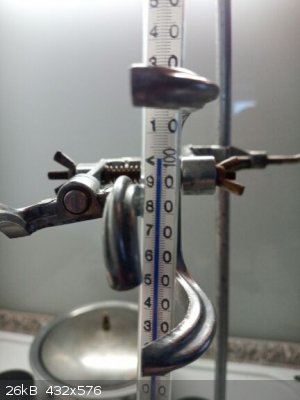
17:01:08

17:03:09
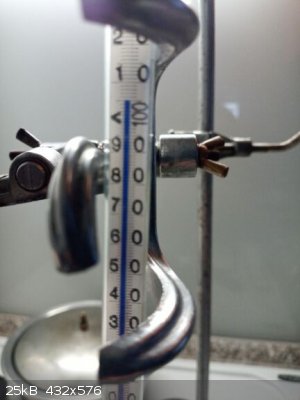
17:03:27

17:05:49
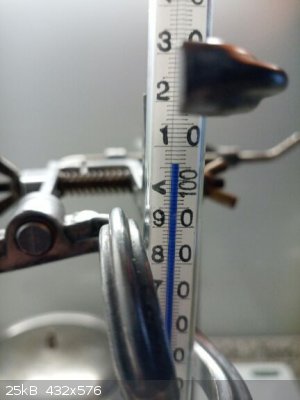
17:05:59

[Edited on 29-2-2020 by Fery]
|
|
|
DraconicAcid
International Hazard
    
Posts: 4355
Registered: 1-2-2013
Location: The tiniest college campus ever....
Member Is Offline
Mood: Semi-victorious.
|
|
Quote: Originally posted by Fery  | | j_sum I did it because of pineapple scent. I have almost every aliphatic carboxylic acid upto C9 (all including branched for upto C5 and only straight
chain C6-C9) and I searched which esters have pineapple scent and especially pure pineapple as a lot of them are not pure pineapple.
|
I'm actually having my organic students make a variety of esters in the lab, just so we don't get the same smell every year (in first year, they made
methyl salicylate and isoamyl acetate, and until I took over the organic labs, they made more isoamyl acetate in second year, and I was getting really
sick of fake banana). I have learned that tertiary alcohols simply don't work- do you have any favourite esters for smells?
Crotonates, so far, either smell unpleasantly like caramel, or like mushrooms....
Please remember: "Filtrate" is not a verb.
Write up your lab reports the way your instructor wants them, not the way your ex-instructor wants them.
|
|
|
Fery
International Hazard
    
Posts: 1026
Registered: 27-8-2019
Location: Czechoslovakia
Member Is Offline
|
|
I just searched databases and grabbed all scents pure for pineapple.
I love pears too (1-pentanol + acetic acid) - so much that I rather bought 1 L flask with the ester instead of synthesizing it.
For tertiary alcohols convert to bromide or chloride with hydrobromic/hydrochloric acid and react with Na salt of organic acid.
Tert-butanol probably introduces camphor-like scent into its products?
From the pineapple scents the best are ethyl hexanoate (easy to synthesize) and allyl valerate (medium difficulty).
Just do not wash allyl valerate with NaHCO3. I'm still speculating why did it decompose so much with NaHCO3. I had another idea, there could be traces
of unsaturated hydrocarbons in hexane which could react with H3PO4 and produce some catalyst for hydrolysis, who knows?
|
|
|
DraconicAcid
International Hazard
    
Posts: 4355
Registered: 1-2-2013
Location: The tiniest college campus ever....
Member Is Offline
Mood: Semi-victorious.
|
|
I find that the literature descriptions of most esters are laughably specific (apples, pears, plums, apricots) when most of them smell like a generic
"tutti-frutti" odour. Methyl anthranilate is definitely grape, isoamyl acetate is atrificial banana, but most of the rest aren't specific.
Please remember: "Filtrate" is not a verb.
Write up your lab reports the way your instructor wants them, not the way your ex-instructor wants them.
|
|
|
karlos³
International Hazard
    
Posts: 1520
Registered: 10-1-2011
Location: yes!
Member Is Offline
Mood: oxazolidinic 8)
|
|
Quote: Originally posted by DraconicAcid  | | I find that the literature descriptions of most esters are laughably specific (apples, pears, plums, apricots) when most of them smell like a generic
"tutti-frutti" odour. Methyl anthranilate is definitely grape, isoamyl acetate is atrificial banana, but most of the rest aren't specific.
|
Thank you, finally someone confirms that!
I always thought my nose must be less well than others, since I feel the same.
Generic tutti-frutti describes it very well, I mean, I could hardly diffentiate n-butyl acetate from benzyl acetate or methyl benzoate for example.
I can differentiate them all from ethyl acetate of course or other esters who are likewise that specific.
The people who describe their odours that specific must have such fine noses as the people who create smells for the perfumery industry.
I mean, I can tell if it is more fruity, more flowery, but all in all most just smell like artificial fruit-flower mixtures.
But maybe that could be caused by smelling them not diluted enough to be able to catch their finer underlying odourous notes?
And sorry for the OT, but I just had to say it.
|
|
|
DraconicAcid
International Hazard
    
Posts: 4355
Registered: 1-2-2013
Location: The tiniest college campus ever....
Member Is Offline
Mood: Semi-victorious.
|
|
Methyl benzoate, I find, is very different from the majority of butyrates and acetates I've made. Slightly similar to salicylate. Methyl cinnamate
is clearly strawberry. The rest of them....generic fruit.
Please remember: "Filtrate" is not a verb.
Write up your lab reports the way your instructor wants them, not the way your ex-instructor wants them.
|
|
|
DraconicAcid
International Hazard
    
Posts: 4355
Registered: 1-2-2013
Location: The tiniest college campus ever....
Member Is Offline
Mood: Semi-victorious.
|
|
Quote: Originally posted by Fery  |
For tertiary alcohols convert to bromide or chloride with hydrobromic/hydrochloric acid and react with Na salt of organic acid.
Tert-butanol probably introduces camphor-like scent into its products? |
Have you tried this? I have a prep for t-butyl acetate (supposedly smells of blueberries) from t-butanol and acetic anhydride (with zinc chloride
catalyst), but haven't gotten around to it yet.
Please remember: "Filtrate" is not a verb.
Write up your lab reports the way your instructor wants them, not the way your ex-instructor wants them.
|
|
|
Fery
International Hazard
    
Posts: 1026
Registered: 27-8-2019
Location: Czechoslovakia
Member Is Offline
|
|
DraconicAcid - I did not try that yet. Tert-butanol + acetic anhydride catalysed by ZnCl2 seems to be a nice way to go too, thx for the tip.
Tert-butyl acetate should have camphor or blueberry-like odor:
http://www.thegoodscentscompany.com/data/rw1039901.html
but there is only 1 report from 1 supplier about its scent and all other suppliers (approx 10) do not mention anything about its scent so it is very
likely not used as a fragrance.
|
|
|
Fery
International Hazard
    
Posts: 1026
Registered: 27-8-2019
Location: Czechoslovakia
Member Is Offline
|
|
This is quite surprising for me, I found a pineapple scent sold in my country and most of its content are allyl esters
2-Propenyl phenoxy-acetate = allyl phenoxyacetate
Allyl hexanoate
then non-allylic compounds: Benzyl Salicylate, Limonene - both seems to be only modificators as they do not have pineapple scent (Benzyl Salicylate
should have balsamic scent, Limonene if it is D-limonene has orange scent, L-limonene has turpentine scent), so for the pineapple scent are
responsible both allyl esters
https://eshop.ekokoza.cz/cs/ananasova-vune.html
|
|
|